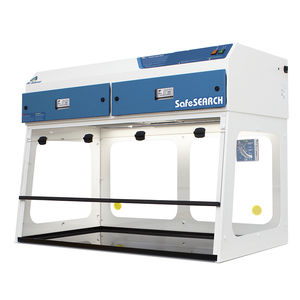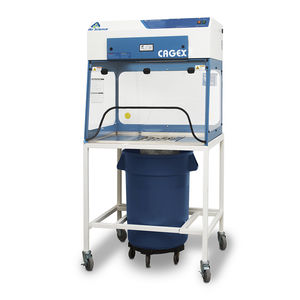

- Products
- Catalogs
- News & Trends
- Exhibitions
Rotary evaporator enclosure P5-36containmentbenchtopductless
Add to favorites
Compare this product
Characteristics
- Function
- containment
- Applications
- for rotary evaporators
- Configuration
- benchtop
- Exhaust mode
- ductless
- Other characteristics
- custom
- Depth
610 mm
(24.02 in)- Height
1,270 mm
(50 in)
Description
In the laboratory, a rotary evaporator (rotovap) is employed to remove volatile solvents or isolate components of reaction mixtures by evaporation. This may be done following a separation or extraction process. During rotary evaporation, the solvent is removed under vacuum and is subsequently trapped by the condenser and collected.
Although a rotovap is designed to condense and collect evaporated solvents, the possibility exists for small amounts of volatiles to escape the apparatus, posing potential risks of chemical fume exposure, explosion or implosion. These applications warrant additional protection for laboratory personnel by placing the unit in a fume hood or enclosure, minimizing potential risks associated with inhalation of noxious fumes and guarding against injury from exploding or imploding glassware. Since safety is critical to a successful laboratory outcome, ensuring the correct equipment is in use is vital to that success.
Air Science® Rotovap Custom Enclosures and Purair® Basic and Advanced ductless fume hoods are engineered to provide protection and containment during rotary evaporation applications in the laboratory. These units provide containment for the rotovap while permitting operator access and visibility of the enclosed operation. From customizable Rotovap Enclosures to affordable ductless fume hoods, Air Science protects your personnel during rotary evaporation procedures
ROTARY EVAPORATION SAFETY CONSIDERATIONS Use of a rotovap in a fume hood or enclosure minimizes the risk associated with hazardous fume inhalation and protects from injury resulting from exploding or imploding glassware.
Catalogs
Related Searches
- Hospital cupboard
- Upright refrigerator
- 1-door refrigerator
- Laboratory refrigerator
- Automatic defrost refrigerator
- Stainless steel cupboard
- 2-door cupboard
- 1-door cupboard
- Single-module cabinet
- Laboratory fume extractor
- Laboratory cupboard
- White cabinet
- Mobile cabinet
- Medication cabinet
- Biological safety cabinet
- Laboratory biological safety cabinet
- Benchtop hood
- Dental facility cabinet
- Class II biological safety cabinet
- Laboratory material cabinet
*Prices are pre-tax. They exclude delivery charges and customs duties and do not include additional charges for installation or activation options. Prices are indicative only and may vary by country, with changes to the cost of raw materials and exchange rates.










